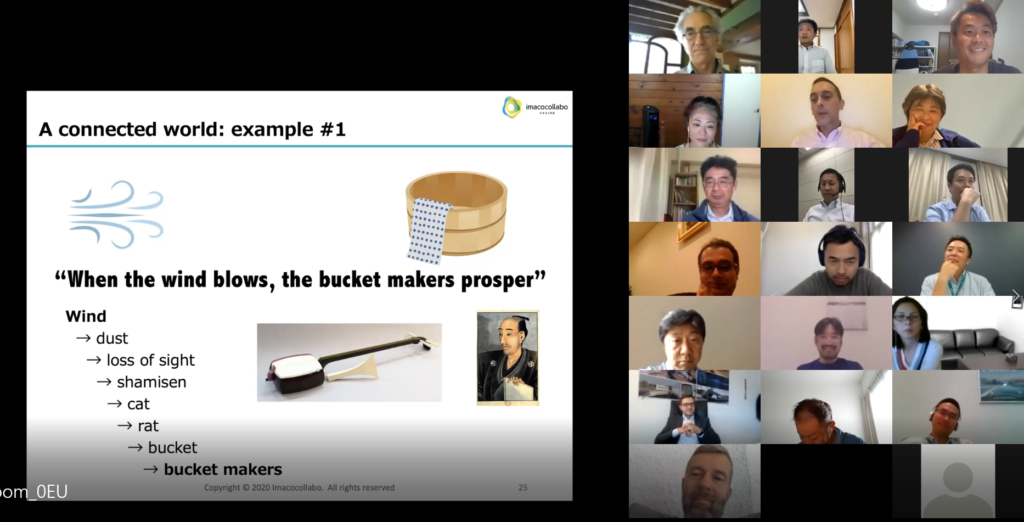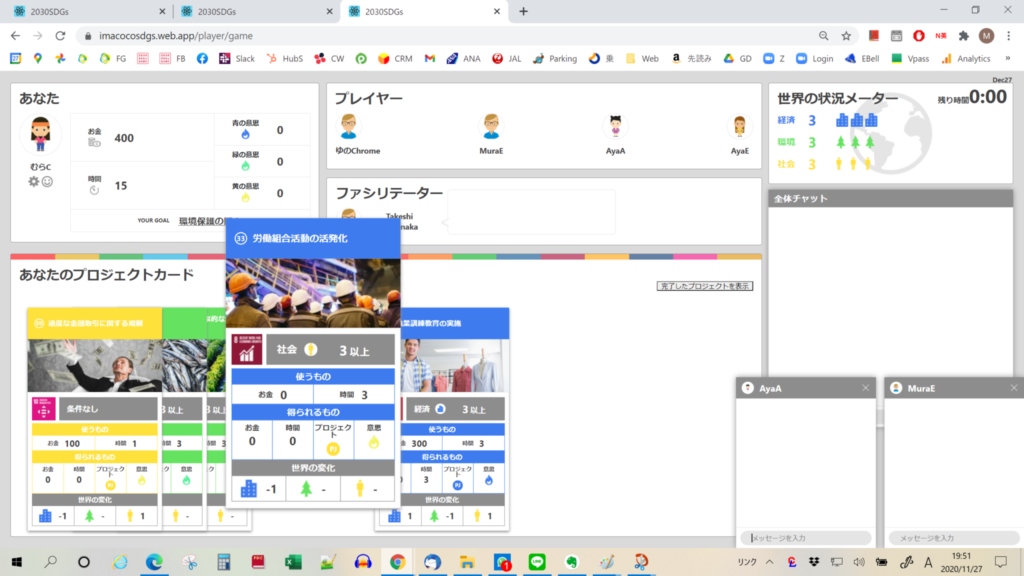
Nagatadai Municipal Elementary School in Yokohama City, Japan, a UNESCO approved school by Associated Schools Project Network, incorporates ESD (education for sustainable development) in its curriculum. Facilitators presented the2030 SDGs Game to fifth grade students.
Mr. Mikami, a fifth grade teacher, commented:
“These children have been studying about the environmental issues that interest them since they are in the fourth grade. This year, I would like them to understand that all of the issues are connected to each other. By experiencing the game, I hope that they become aware of connections between the seventeen goals and experience the impact of their own actions on the condition of the world.”
The walls of the classroom were filled with posters displaying students’ exhibits from past events about the environment and their comments on previous SDGs classes. This was a clear indication of how much the children’s interest in the SDGs had been elevated.
The world changes as we take action

From the start of the game, the classroom was bustling with energy. Some teams hurried to achieve their projects quickly, while other teams immediately began to negotiate with the teams around them. “Help, I need more money!!” The facilitators were amazed at how quickly they got the gist of the game.
However, their movement began to slow down after a while. Several children stared at the World Condition Meter, expressed by magnets on a whiteboard.
“I want to do this project, but the (green) Environment meter is too low for me to do it.”
In order to achieve some projects, there are conditions to be met. For example, the World Condition Meter has to be at a certain level: some project cards requires the Environment (green) to be at 3 or more points to run it.
“Oh no, look! It’s getting bad!”
Looking again at the world condition meter, Environment (green) and Society (yellow) points had gone way down while the Economy (blue) was growing at a fast pace.
Somehow, while they were looking at their own cards and trying to reach their goals, the world had dramatically changed! This realization reliably dawns on the players at some point during the game.
The facilitators called out, “Speak up about what you want that you need help with” to make it clear what was happening in their world.
Then each team started telling each other their goals and how much money and time they needed to achieve them.
At this point the first part ended, at which time 3 out of 10 teams had achieved their goals. How would these young people think and act in the second part of the game?
Does this project benefit society?

When the second part of the game began, their actions were clearly different from the first part. Conversations such as these were heard:
“Anyone have projects that will add more green?”
“How about this one? Wait, blue will go up but yellow will go down.”
The teams who had already achieved their goals went around to other teams and asked questions such as: “What are you looking for?” or “Are you going to run this project? Won’t that use too much Time?”
Compared to the first part, where they were focusing on their own goals, the behavior of the children in the second part changed, with some looking for “a better way for everyone” by watching what was going on in the world as a whole.
One boy was thinking intently and looking at his cards.
“If I run this project I can reach my goal, but the project says “Promote Concentration of Social and Business Functions in Metropolitan Areas,” and I’m wondering if it will benefit society… wouldn’t it cause depopulation elsewhere?”
He said that he had watched a TV news program on the depopulation issue.
The children seemed to be considering the impact of the projects themselves and how they would affect the world, connecting them with things that they have learned in their daily life experience. The boy thought deeply for a while, then went to look for a team who had project cards that would have less impact on the environment and society.

We want to play again!
When the second part was over, three more teams had achieved their goals, and the meters of the Environment (green) and Society (yellow) had both increased a little.
It was time for reflection.
Each child wrote down their discoveries on post-its.
One student reflected on her own behavior, saying, “I made a plan at the beginning, but after a while I couldn’t follow it because I did not have enough time cards. I should have planned better.”
Other students saw how the game was like the real world, saying “it was hard to get points for the environment and society, I think our real society is like that too,” or “by playing the game, I realized that the world is all connected.”
Snack foods impact the world?
Then the children were invited to deepen their understanding about individual actions and how that could impact the world.
“Do you know how the oil used to produce snacks such as potato chips are is made?”
The facilitator explained how the use of palm oil can lead to illegal deforestation and labor problems. Since the children were already aware of the connections between themselves and the world through their experience of the game, they listened to the facilitator with intent, serious gazes.
“Just like some of you were noticing things like the green points were decreasing, the purpose of the SDGs is to set goals to make the world condition clear and understandable.
You may also have seen while playing the game today how the conditions of the world meter and everyone’s actions are connected.”

following feedback:
“I heard children persuading others by expressing themselves clearly, saying things like, “I want this card because I want to achieve this project.”
“Much negotiation among teams happened all around the classroom, which might connect to the “Partnership goals” in the SDGs.”
“I saw many possibilities to connect this experience to different topics.”
“I saw the game bring out the best in the children, some negotiating and others planning or calculating. I didn’t see anyone looking left out. All of them seemed to be having fun working toward their goals.”
“They listened so carefully to the story of the connection between snacks and the environment. Their experience of the game seems to have helped deepen their learnings about those issues.”
The children, who had until then studied various individual social issues, learned how those issues all connected to one another and to themselves through the virtual experience of playing the game.
The class gave them an opportunity to deepen their own personal sense of how their behaviors and actions can make an impact on social issues.





